The Curious History of an Exile from the Thomasschule: Some Observations on the Provenance of the Original Figured Organ Player's Part to
Christ unser Herr zum Jordan kam, BWV 7 Page at the Teri Noel Towe Home Pages
Johann Sebastian Bach
The Curious History of an Exile from the Thomasschule:
Some Observations on the Provenance of the
Original Figured Organ Player's Part to
Christ unser Herr zum Jordan kam, BWV 7
Important Note: This page in under major revision
Important additions are planned to be added this page. Please read this page with caution (TNT, December 2014).
This remarkable photograph is not a computer generated composite; the original of the Weydenhammer Portrait Fragment, all that
remains of the portrait of Johann Sebastian Bach that belonged to his pupil Johann Christian Kittel, is resting gently on the surface
of the original of the 1748 Elias Gottlob Haussmann Portrait of Johann Sebastian Bach.
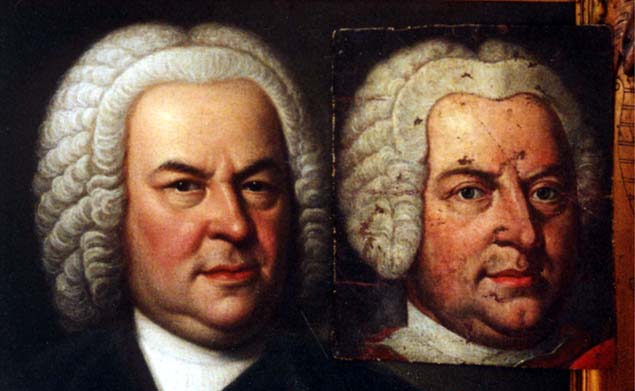
1748 Elias Gottlob Haussmann Portrait, Courtesy of William H. Scheide, Princeton, New Jersey
Weydenhammer Portrait Fragment, ca. 1733, Artist Unknown, Courtesy of the Weydenhammer Descendants
Photograph by Teri Noel Towe
©Teri Noel Towe, 2001, All Rights Reserved
The Figured Organ Player's Part to Christ unser Herr zum Jordan Kam,
BWV 7
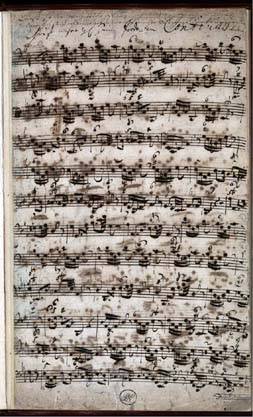
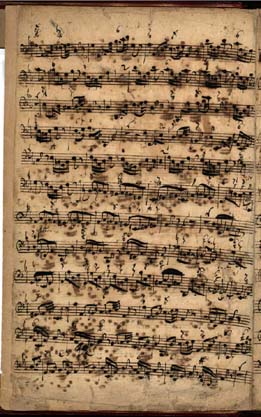
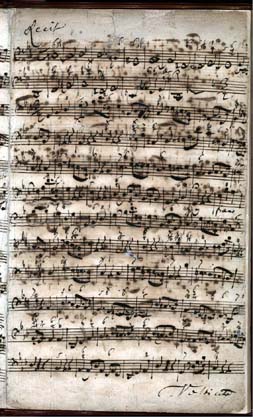
Pages 1, 2, and 5

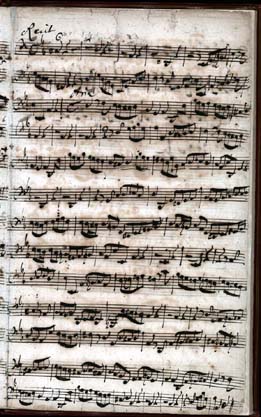
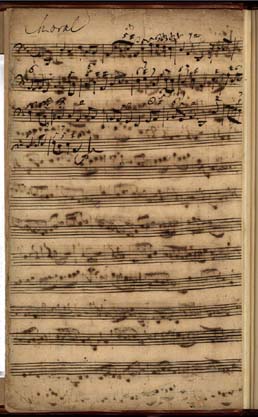
Pages 6, 7, and 8
Links to Large Size Color Digital Scans of the Part
Front cover
Inside front cover
Inside front cover - detail - sale catalogue entry
Page 1
Page 1 - detail - Sigismund Neukomm's inscription at the top of the page
Page 2
Page 5
Page 6
Page 7
Page 8
The Curious History of an Exile from the Thomasschule:
Some Observations on the Provenance of the Original Figured Organ Player's Part to
Christ unser Herr zum Jordan kam, BWV 7
This is the now twice revised and expanded text of a presentation that I made at the 1989 meeting of the American
Chapter of The New Bach Society [now The American Bach Society], at Harvard University in Cambridge,
Massachusetts.
I vividly recall the disbelieving but resigned expression that crossed the face of Robert Crow, the American History teacher who ran
the bookstore at Deerfield Academy, when I asked him to order a copy of Wolfgang Schmieder's Bach Werke Verzeichnis for me.
It was during the 1965-1966 academic year. I was seventeen years old, a senior in prep school, and I confess that I did (and
probably still do) have a reputation for being a wee bit odd. Card-carrying Bach fanatics of that relatively tender an age are rather
few and far between, you must admit. I also vividly recall my elation when the book at last arrived, on January 29, 1966, according
to the date I wrote on the flyleaf. (It cost the then princely sum of $17.50, an amount that, for obvious reasons, I have found easy to
remember.) I took my long-coveted Schmieder back to my dorm room. With the Langenscheidt in hand, I delved into the massive
brown and gold dust-jacketed volume in my lap, quickly learning what expressions like "Echtheit angezweifelt" and "Quellen"
meant.
"Quellen", of course, means "sources", and I found it particularly fascinating to learn the all too often chillingly tenuous threads
upon which the survival of too many of the masterpieces of Sebastian Bach have hung. But, I confess, I was already a rabid
collector and aggregator. (At 17, I already owned nearly 1,000 records, many of them 78s that subsequently have turned out to be
very valuable. You see, the repertoire that I had to pay $5.00 for on LP I could pick up on 78s in the charity thrift shops for 25
cents. I was introduced to the artistry of such greats as Edwin Fischer, Wilhelm Furtwängler, Gioconda da Vito, Albert Coates,
Alfred Busch, Pol Plançon, Mattio Battistini, the Lener Quartet, and Artur Schnabel, by virtue of that simple financial expedient.) I
was, therefore, also curious about what there was in the hand of Sebastian Bach that was floating about in private hands that might
one day, in the land of my wildest dreams, be within my grasp. The first such item that I spotted cropped up in the listing for the
Cantata, Christ, unser Herr, zum Jordan kam, BWV 7:
"Autograph. Stimmen (nur z. T. autogr.), Leipzig im Besitz der Thomasschule. - Cont.-St. mit Bibliotheksstempel von S.
Neukomm, 6 Seiten 2o. Aus d. Aug. Eberhard Müllers, der das MS. Sigismund Neukomm schenkte. Angez. in Verst.-Kat. 41
[1913] von Leo Liepmannsohn unter Nr. 1966, gegenwartiger Besitzer nicht bekantt."
In that way, I learned that the chances were good that, somewhere in private hands, its whereabouts unknown to Schmieder, was
the figured organ part for this Cantata for the Feast Day of St. John the Baptist, that had left Leipzig to enter the collection of
Haydn's beloved pupil Sigismund Neukomm during the early part of the 19th century. But I had more important things, like college
and professional school, to worry about.
Still, I couldn't get away from Cantata No. 7. As an undergraduate at Princeton, I sought out and came to number among my most
treasured friends and mentors, William H. Scheide, who lived then, as now, a few blocks from the campus. In generously sharing
his personal collection of lacquers and tapes of Bach Aria Group concerts with me and with listeners to my radio show on the
university station, WPRB, he introduced me to Christ, unser Herr, zum Jordan kam, and to this day that privately made recording
of a performance given in Town Hall in New York on February 8, 1961, is the only account of the work that I consider acceptable.
And that includes my own reading, recorded at the concert given at the University of Virginia in 1973 that marked both my debut
and my retirement as a conductor.
Little did I know at those stages in my life that, on a chilly October morning in 1983, I was destined to become a footnote in the
Bach literature, a statistic in the "Quellen" listings. I shall never forget the thrill of sitting down in my living room with the single
largest purchase I had so far made in my life, to turn the pages of this invaluable bit of Bachiana, and follow Paul Ulanowsky as he
realized so suitably and so beautifully the basso continuo figures that were before me in, at the very least partially, if not entirely,
Bach's handwriting. And then a peculiar realization came over me: There was no glass case between me and the manuscript; there
were no guards, no closing hours. What had once been a part of Sebastian Bach's library was now a part of mine.
And I fully understood that I had not just bought a performing part. I had bought a leasehold, if you will, that brought with it a
singular and inestimable responsibility: to cherish, protect, and then ultimately pass on to yet another custodian an invaluable and
irreplaceable direct link to the composer whom, since childhood, I have revered as the greatest of all. So, I think that, in a peculiar
way, it is only right that I make it my personal responsibility to clarify to the extent that I can the curious and cryptic history of this
exile from the Thomasschule, the figured organ player's part for Christ, unser Herr, zum Jordan kam.
It is best, I think, to begin with a description of the part, and, for that, I am going to take the liberty of quoting in extenso from
Gerhard Herz's Bach Sources in America:
"The autograph score of this cantata has not survived. While the parts have been preserved and are now in the Bach-Archiv
Leipzig, one of them, the figured and transposed continuo part, has found its way to America. The transposition of the continuo
part one whole tone down (from E to D Minor) is characteristic of Bach's organ parts written in Leipzig. The continuo manuscript
consisted originally of eight pages of music written on four leaves of two folios. The leaf with the original pages 3 and 4 is missing.
It must have contained the end of the opening movement and the second movement, a Bass aria in G Major, notated of course in
the key of F Major. The six extant pages of this manuscript along with a number of blank protective pages have been bound in old
dark-red morocco. The size of the manuscript is 35.5 x 21 cm. The color of the paper is moderately brown, that of the ink
black-brown. Although the ink has eaten its way through about a dozen noteheads and the lower corners of the pages are worn and
soiled (especially page 1), the general condition of the manuscript is still quite good. The watermark of the large Halfmoon which
shows only on the third leaf assigns this cantata to Bach's chorale cantata Jahrgang....
The first page of the continuo part... is prefaced at the very top by an early owner of the manuscript, the well-known Haydn disciple
and composer of over a thousand works, Sigismund Neukomm, who writes: "Dies ist die Handschrift des grossen Joh. Sebast.
Bach. Sein Nach/folger H: [= Herr] A. E. Müller gab sie mir auf meiner Durchreise durch Leipzig zum/Andenken." ("This is the
handwriting of the great Joh. Sebast. Bach. His successor Herr A. E. Müller gave it to me as a souvenir when I passed through
Leipzig.") Below this barely legible inscription appears the heading "Christ unser H [= Herr] zum Jordan kam Continuo". The
handwriting of this caption as well as of the whole manuscript is that of Christian Gottlob Meissner. His handwriting resembles that
of Bach to an extraordinary degree."
Here is a scan of the inscriptions at the top of Page 1. I take my hat off to Gerhard for being able to decipher Neukomm's
annotation. It is barely legible.

That Meissner's handwriting resembles Sebastian Bach's "to an extraordinary degree" is perhaps the Bachian understatement of the
century, and the fact that the two hands are nearly indistinguishable has meant that the number of strokes from Bach's pen to be
found on these six pages bound in red morocco has been the subject of controversy and dispute.
Gerhard Herz observed, quite accurately, that:
"The 'pia(n)' on page 2  as well as the 'piano' on page 3 [Page 5 of the original manuscript]
as well as the 'piano' on page 3 [Page 5 of the original manuscript]  are unquestionably
in Bach's handwriting."
are unquestionably
in Bach's handwriting."
He goes, however, on to aver that:
"As this proves that the composer checked, that is, proofread, his pupil's copy, we have every right to assume that Bach, as was
his habit, added also the figuring of this continuo part...which further shows the persistent undulating figure by which Bach painted
the waves of the river Jordan. In the fourth and fifth movements (= page 5) [except for a lone figure on the first note of the fourth
movement, a recitative] the figuring of the bass is missing. It seems convincing that Bach, in proofreading the continuo part, ran out
of time thus having to omit the figuring. If Meissner had been the one who had entered the figuring conscientiously up to this point,
it would be hard to understand why he should have interrupted his task so suddenly. It thus appears that Bach, not Meissner, added
the figuring from beginning on. Furthermore, the heading "Recit" at the top of page 3 [Page 5 of the original manuscript]
 and the "Recit" at the top of page 5 [Page 7 of the original manuscript]
and the "Recit" at the top of page 5 [Page 7 of the original manuscript]  and two staves below it
the word "Aria"
and two staves below it
the word "Aria"  might also be autograph additions by Bach."
might also be autograph additions by Bach."
But do we actually "have every right to assume that Bach, as was his habit, added also the figuring of this continuo part"?
Others are not so sure. For example, Arthur Mendel was of the opinion that the part was entirely in Meissner's handwriting, a
contention that is clearly incorrect.
On October 28, 1983, my treasured friend and mentor since my freshman year at Princeton, William H. Scheide, sent me a postcard
that reads in part,
"Congratulations! ...I hope for your sake that there may be some genuine JSB tucked away somewhere in the six pages or so. From
other continuo parts I have seen I know it is sometimes hard to be sure which slurs or which figures may be autograph (if any)."
In 1986, Laurence Dreyfus, the author of the then recently published Bach's Continuo Group, wrote me that Meissner
"copied Bach's figures from the Cammerton part in movements 1 and 7... Bach added figures in Movement 1 and by line 6 on page
two of the part, himself figured the remainder of the page. He likewise figured movements 3 and 4. A good example of JSB's hand
is the beginning of the last line on page 2: the nearly connected 7-6 and 4-3 are very typical."
I am certainly nowhere near the specialist in such things that Prof. Dreyfus is, but, personally, I think that Bach is responsible for the
figures on Page 8:

The figures show evidence of having been written in great haste, so fast in fact, that the are sometimes slightly ahead of the notes.
They have been written down with a security and an authority that only Bach himself would have possessed.
"Why the last 17 measures of movement 1 and all of movement 2 are missing from the part eludes me," Professor Dreyfus
continues. "There could well have been an insert that has since been lost, but in such cases Bach usually makes some sign or writes
NB. (nota bene). Curious. Has anyone offered you any explanation for the missing measures and movement?"
No, no one has, but I have my own theory, and it is important, though not crucial, to a convincing explanation of the circumstances
that led to Sigismund Neukomm receiving this part, and not any other, as an "Andenken" from August Eberhard Müller when he
visited Leipzig. But I shall return to that in due course as I attempt to trace the travels of the part from Bach's Componierstube to its
home in my apartment in the garment district in Manhattan.
Questions about the provenance of the figured organ part for Christ unser Herr zum Jordan kam begin, as they do with so many
of Bach's performing materials and autograph scores, with the settlement of his Estate and the undoubtedly stressful circumstances
that surrounded the exodus of his widow and family from the Cantor's apartment in the Thomasschule. (Many scholars and Bach
admirers, by the way, have made disapproving remarks about Bach's failure to make a will, but, as an estates lawyer, I have to say
that the estate planning notions that we take for granted today are a relatively recent development, and that the rules of descent and
distribution that applied in Central Europe in the 18th century do not appear to have born much resemblance to those that applied in
those countries with an Anglo-American legal system, then or now. It may well have been that, as is the case today in the so-called
Napoleonic Code countries, Bach would not have been able to have altered the statutory descent and distribution pattern to any
significant degree by will. A jurisprudential doctoral candidate with a music historical bent could find quite an interesting thesis topic
here.)
In any event, the basic outline is well known. The Estate inventory is not complete. (If it is, Bach must have cut an interesting figure
on the streets of Leipzig, for, according to the inventory, he owned no pants and no socks. Surely he didn't wear cantorial robes all
the time!) Wilhelm Friedemann and Carl Philipp Emanuel divided the scores and parts to the sacred works between themselves
unevenly, "Friede" getting the lion's share because, at that stage of his career, he could make more practical use of the sacred
works. Anna Magdalena, however, did manage to retain the performing parts for a whole jahrgang of Cantatas, namely the Chorale
Cantata cycle begun in the late spring of 1724. (Friedemann got the autograph scores, as the subsequent histories of other scores in
the Chorale Cantata Jahrgang make clear.) Soon thereafter, Anna Magdalena sold these sets of parts to the Thomasschule,
receiving as payment an amount equal to a half year of her husband's salary. (Bach's remark in his famous letter to Georg Erdmann
of 1730 about how high the cost of living was in Leipzig seems particularly poignant when considered in this context.)
The first question to be considered, therefore, is: Did Wilhelm Friedemann have the parts to Christ unser Herr zum Jordan kam, or
did Anna Magdalena have them? Since there appears to have been no inventory of the sets of parts that Anna Magdalena sold to the
Thomasschule, we have no easy answer to the question. That the remaining parts to BWV 7 are still kept in a library wrapper similar
to those in which the other sets of parts bought from Anna Magdalena were placed is strong evidence in support for the parts to
BWV 7 being one of the forty-some-odd "Anna Magdalena" sets, but the matter is further complicated by the fact that Wilhelm
Friedemann was a close friend of August Eberhard Müller's uncle. Once again I quote from my good friend, Gerhard Herz:
"During his stay in Braunschweig (1771-74) Friedemann lived in the house of Herr Müller, later the organist at the Braunschweig
Cathedral, to whom Wilhelm Friedemann gave, among other manuscripts, his father's Inventions and Sinfonias and Book I of the
Well-Tempered Clavier. On the first page of the continuo part Neukomm relates that he received it from J. S. Bach's 'successor A.
E. Müller.' (The E could also be read as C). Successor can only mean Thomas cantor; and there is only one Thomas cantor by the
name of Müller, namely August Eberhard (A. E. not A. C.) Muller, born in 1767 in Northeim. He lived for a time with his uncle in
Braunschweig. As the latter was, as mentioned above, in possession of quite a number of Bach manuscripts, it seems at least not
implausible that he may have given the continuo part to his gifted young nephew.
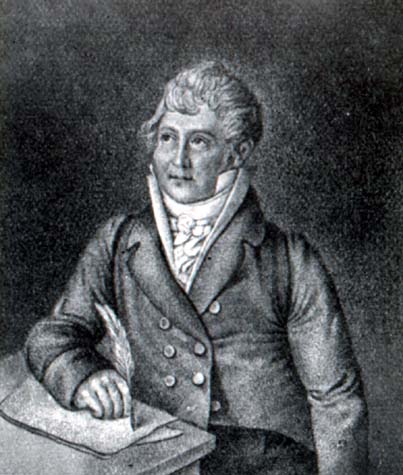
August Eberhard Müller (1767-1817)
Since A. E. Müller also studied with Johann Christoph Friedrich Bach in Bückeburg it is likewise conceivable that he received the
continuo part from him. Be that as it may, A. E. Müller, organist at the Nikolai-Kirche in Leipzig in 1794 and Thomas cantor in
1804, became somehow the owner of the manuscript. Between 1804 and 1809 when he resigned his cantorship - the first Thomas
cantor in history to do so - he presented the manuscript to Sigismund Neukomm...."
In a footnote Professor Herz dismisses the possibility that Müller gave Neukomm a performing part that came from the collection of
the Thomasschule:
"That Müller, who as Thomas cantor had access to the parts of the 44 Bach cantatas that were in the School's library, should have
singled out this continuo part, that is stolen it to give it to Neukomm as a present, seems too preposterous an idea to be taken
seriously."
That Müller stole the part to give it to Neukomm is preposterous, I agree, but that the part came from the library of the
Thomasschule is not. To arrive at a plausible, in fact, a logical, explanation of why the part had to have come from the library of the
Thomasschule rather than from Müller's one must consider not only an important flaw in Professor Herz's hypothesis but also the
circumstances surrounding Müller's having to make the gift of a sample of Bach's handwriting to Neukomm in the first place and the
peculiar character of the performing part selected in the second place.
The problem that I have with Professor Herz's conclusions regarding the provenance of the continuo part concerns the other parts
in the set. If either his uncle or Johann Christoph Friedrich Bach gave the continuo part to August Eberhard Müller, how did the
other parts in the set find their way into the library of the Thomasschule? If he received the entire set as a gift, why did he leave the
parts - minus the one he gave to Neukomm, of course - behind when he left Leipzig to go to Weimar as Capellmeister in 1809?
That he might have had a less than appreciative attitude towards Sebastian Bach and his Nachlass could be inferred from his
decision to leave the 1746 Haussmann portrait that he almost certainly had acquired for his own collection some years before
behind in Leipzig as a gift to the Thomasschule, where it hung in the dining hall, unappreciated and susceptible to damage, for years
afterwards. But a portrait is more cumbersome and more costly to move than a set of parts, and it is the bulky things that we are all
inclined to "de-accession" when we move house, especially when it is from one city to another, over rough and bumpy dirt roads.
(Remember Carl Philipp Emanuel Bach's comment to Forkel about the dangers of moving pastels, even if on a riverboat?)
No, no disrespect intended to my dear friend Gerhard, I cannot believe that Müller gave Neukomm a performing part from his own
collection. It had to have come from the library of the Thomasschule. First of all, it is not the only one, by any means, to have been
"de-accessioned", for lack of a better word. There are parts from other cantatas in the Chorale Cantata Jahrgang, most notably
from Herr Gott, Dich loben alle wir, BWV 130, that are now in collections other than that of the Thomasschule (now, of course,
in the Bach Archiv in Leipzig), and still others have been lost (the performing parts to Mache dich, mein Geist, bereit, BWV 115,
for example). Clearly, the authorities at the Thomasschule in the late 18th and early 19th centuries did not have a Fafner complex, if
you will, about their Bach holdings. (If only they had! I would not be the proud and grateful possessor of a partially autograph
continuo part, admittedly, but posterity's losses would not be as severe.) Second of all, the evidence of the "official" Thomasschule
wrapper mentioned earlier is strong support for its having been the property of the School.
So, accepting the premise that the performing parts to Christ unser Herr zum Jordan kam were in the library of the Thomasschule,
why did Neukomm receive the part he did and what were the circumstances? Some enlightenment is provided by Neukomm's
biography. Born on July 10, 1778, in Salzburg, this favorite pupil of Joseph Haydn was, at the age of 30, already a musician
renowned throughout Europe when he passed through Leipzig in the summer of 1808. It was at this time that he was given the
continuo part, for it was then and only then that Neukomm visited Leipzig during Müller's five-year tenure as Thomascantor. He had
just spent four years in the Imperial Russian capital of St. Petersburg, as Capellmeister of the German Theatre, and two years
before, at the age of 28, he had been honored with election to the Swedish Royal Academy. Neukomm had left St. Petersburg on
June 8, 1808, to return to Vienna, arriving in the Austrian capital by mid-November.
On the way he passed through Riga, Memel, Konigsberg, Berlin (where he visited Carl Friedrich Zelter), Dresden, Leipzig,
Nürnberg, München, and his native Salzburg. Unfortunately, Neukomm provides no further details of the journey in his
autobiography, and makes no mention of having received the gift of the continuo part. I suspect that he asked Müller for a sample
of Sebastian Bach's handwriting, and the Thomascantor considered him too distinguished a visitor to refuse the request.
Whether Müller in fact had to ask his superiors' permission to give Neukomm a performing part is anybody's guess. Personally, I
feel that, as the equivalent of the Dean of Students at a modern-day New England prep school, Müller had the authority to make
such a gift on his own, but, for the sake of the argument, let's assume that he did have to ask the Rector. Müller would simply have
explained to his boss that Neukomm was too renowned a musician to say, "No" to, and, that, besides, any of the figured organ
parts to any of the cantatas in the Chorale Cantata Jahrgang could be given to him without effective loss to the set of parts from
which it was extracted, since all the figured organ parts would have been superfluous to and useless in performance in any of the
Leipzig churches by 1808 anyway. (Incidentally, virtually every one of the 44 sets of parts that Anna Magdalena sold to the
Thomasschule contained a transposed continuo part as well as one written "at pitch" when delivered to and accepted by the
Thomasschule's library. These parts, however, were not used in performance as a general rule, as Bill Scheide has enlightened me;
they were intended for rehearsal use and were used in performance on those rare occasions when the organ was out of order.)
Remember, all of the figured organ parts from the original sets of performing parts to the Leipzig cantatas are transposed parts,
written a whole tone down so that the music would sound in the "right" key when played on the organs in either the Nicolaikirche or
the Thomaskirche in Bach's day. The pitch of the organs in both of those churches almost certainly had been lowered to
Cammerton by Neukomm's day. In the case of the Nicolaikirche, that took place in 1787, when a new organ by Christian and
Johann Gottlob Trampeli completely supplanted the Thayssner organ that Bach had known.
The history of the pitch of the organ in the Thomaskirche is less clear, but that instrument had been subjected to many repairs and
at least one major rebuild in the 58 years between Bach's death and Müller's gift to Neukomm. In 1772, Johann Gottlieb Mauer
made repairs so extensive that, for all practical purposes, he rebuilt the organ; his pupil Gottlieb Gottlich made further repairs in
1784-1785; and another major rebuild took place in 1795, the year after Müller took over as organist of the Nicolaikirche. Even
though Arnold Schering advanced the position that the lowering of the pitch of the Nicolaikirche organ was an exception to the rule
when it was carried out in 1787, it is not only likely, but also logical, that the pitch of the Thomaskirche organ was lowered in 1795,
if not earlier. First, of all, such a lowering would have standardized the pitch in the two main churches for which instrumentally
accompanied sacred music was provided by choristers from the Thomasschule. Second of all, the Trampeli brothers, who had
built the new Nicolaikirche organ in 1787, carried out the rebuild of the Thomaskirche organ in 1795, and surely would have been
pre-disposed to lower the pitch of the instrument, even if they had not been specifically instructed to do so.
Still, even if the pitch of the organ in the Thomaskirche had not been lowered by 1808, the chances of the parts for any Bach
cantata being needed frequently for performances in any Leipzig church, particularly on a feast day like that of St. John the Baptist
for which Christ unser Herr zum Jordan kam was written, were remote, to say the least.
If a figured organ part was the least damaging part to give away, why was the part from Christ under Herr zum Jordan kam
selected as Neukomm's "Andenken"? Once more, it cannot be proven for certain, but my surmise is that it was chosen because it
already was missing a page. It is impossible to say when the original third and fourth pages were excised, but a careful examination
of the part in its binding -- which is English, by the way, and Neukomm spent a lot of time in England, beginning in 1829 -- shows
that the leaf was removed before the manuscript was bound. Of course, it is not possible for me, or anyone else for that matter, to
prove that Neukomm himself, or perhaps a subsequent owner, if Neukomm was not, in fact, the person who had the manuscript
bound, did not cut the folio in half and give away the now missing leaf, but a careful consideration of the circumstantial evidence
provided by an examination of what is missing hints strongly that the nasty deed was done before the manuscript left Leipzig.
The missing leaf contains the last 17 measures of the opening chorus and all of the bass aria "Merkt und hört, ihr
Menschenkinder". I surmise that an unscrupulous bass, and a lazy one at that, who happened to have access to performing
materials in the library of the Thomasschule literally "ripped off" this leaf to spare himself the chore of copying out the
accompaniment to an aria he wanted to have in his repertoire. And basses being what they are (and I say it as one who, mercifully,
no longer inflicts his raspy tone and insecure intonation on the listening public), the fact that the pitch has already been lowered a
step was a fortuitous bonus; after all, there are a few high notes in that wonderful aria.
In sum, it is my contention that a prominent, and perhaps pushy, young musician received this particular performing part, then
honestly believed to be entirely in "the handwriting of the great Joh. Sebast. Bach", as a memento of his visit to Leipzig because it
was both defective and superfluous, and thus could be given away without compromising the integrity of the set of parts from
which it was separated.
The travels, however, of the figured organ part to Christ unser Herr zum Jordan kam after it was given to Neukomm are, it must be
admitted, enshrouded in mystery. He certainly had it in his possession when he arrived in Vienna in the fall of 1808. Between the
middle of November of that year and February of 1809, Neukomm paid daily calls on his teacher Joseph Haydn, then in very poor
health and literally months away from death. I like to think that Neukomm showed this performing part to Haydn, who was an
admirer of Sebastian Bach and who owned a copy of the B Minor Mass, and that the frail old man actually held it in his palsied
hands.
Neukomm settled in Paris in November of 1809, where he moved in the highest circles, both musically and socially. He numbered
among his friends and patrons the diplomat Prince Talleyrand-Périgord, the future King Louis-Philippe, Gossec, Grétry, and
Cherubini. Luigi Cherubini was himself a collector of musical autographs and owned the fragment of the first movement of Ein feste
Burg ist unser Gott, BWV 80, that now belongs to Bill Scheide. Another thing that I like to believe is that Cherubini and Neukomm
got together one day and compared their respective bits of Bachiana! If so, did Neukomm become at all suspicious, when he saw
how different Bach's "composing" hand in the BWV 80 fragment is from his "copyist" hand in the BWV 7 performing part, that
what Müller had given to him was not entirely in "the handwriting of the great Joh. Sebast. Bach"?
Although Paris was to remain his base of operations for the rest of his life, Neukomm was a peripatetic gentleman, to say the least,
and he was always "on the go". From 1816 until the spring of 1821, he lived in Rio de Janeiro and Sao Paulo, where he served as
maestro di capella and music teacher to John VI of Portugal, the Emperor of Brazil. If Neukomm took the part with him, rather
than leaving it for safekeeping in Paris, it was almost certainly the first sample of Bach's handwriting to visit the Americas and
certainly the first to visit South America.
Alas, all of this is mere speculation, for not only does Neukomm make no mention whatever of the part in any of his
autobiographical writings, but also the manuscript is not, according to the distinguished Neukomm authority Rudolph Angermüller,
listed in the inventory of his estate. We, therefore, cannot be sure that Neukomm still owned the part when he died in Paris on April
3, 1858, but, speaking once more as an estates lawyer rather than as an amateur music historian, I can say that the items most easily
passed from one generation to the next without the knowledge of governmental and tax-collecting authorities are jewelry and small
works of arts, like rare books, that can be squirreled away easily. Perhaps Neukomm's heirs did just that with the figured organ
player's part to Christ unser Herr zum Jordan kam.
The part passed through numerous hands between the time it left Neukomm's possession until 1913. According to the annotations
in Volume 2 of the Bach Compendium, compiled by Hans Joachim Schulze and Christoph Wolff (Leipzig, 1987), in which the
Cantata receives the "new" number -- BC A 177, the part passed from Neukomm to one J. N. Kafka. It is listed in catalouges of the
Charavay firm in Paris for sales on May 14, 1881, and again on January 26, 1886. In 1904, it was known to have been in the
possession of a British Member of Parliament. It was sold at Sotheby's in London on July 1, 1907, when it was acquired by a
London based dealer, the Antiquariat B. Quaritch. By this time, the part surely had been bound, because it was in England that it
was bound, whether at Neukomm's instruction or one of its later British owner's. The dark red morocco binding is of mid-19th
century origin, is of English manufacture, and bears on the front cover the legend "John Sebastian Bach / Auto: MSS.".
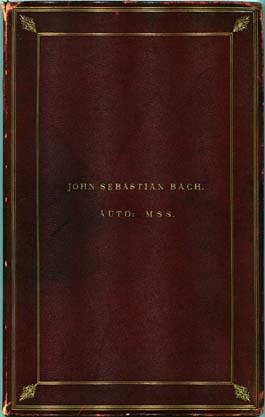
It next appears in the December, 1909, catalogue (No. 130) of the Munich dealer L. Rosenthal. In 1913, the part was included in
Sale Catalogue Number 41 of the renowned Leo Liepmannssohn of Berlin as Number 1966, in a series of sales held on March 27,
28, and 29; the description from that catalogue is glued to the inside of the front cover.
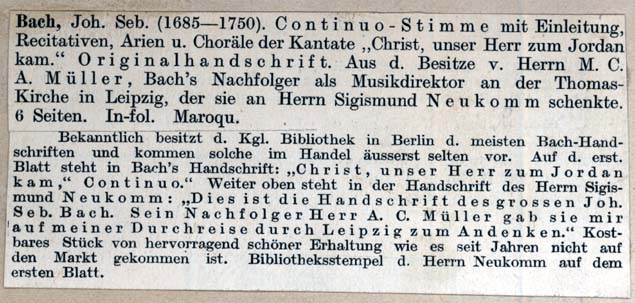
L. Rosenthal bought it back at that sale, apparently, because the part is listed in his catalogue No. 153 in December, 1913.
Who then bought it from L. Rosenthal apparently is no longer known, but twenty years later the figured organ part to Christ unser
Herr zum Jordan kam surfaced again, this time in New York, where it was authenticated on April 6, 1934, by the autograph dealer
Thomas F. Madigan, at the request of a gentleman who had bought it the previous year (The part is listed in Madigan's sale
catalogue for December, 1933) to give to his son, who for many years lived in North Bennington, Vermont, as a 21st birthday
present. I met this lucky, imposing, and affable man, John C. McCullough, at a wedding reception in 1984, and he confessed to me
that, even though he had been a member of the Cantata Singers in New York when Arthur Mendel was its conductor, he had never
heard a performance, either live or on recording, of Christ unser Herr zum Jordan kam, the figured organ player's part to which he
had treasured for a half a century. He also confirmed to me that it came to him with no records of its provenance of any kind. This
lovely curly white haired gentleman parted with it, he admitted to me, because, when he moved from a 35 room house to a 16 room
one, the time had come to simplify his life, and the manuscript was the only such item he owned. A mutual friend later told me that,
when she visited Mr. McCullough, she discovered that the part was always on display, but covered for its protection with a red
velvet pall.
So, a few moments after eleven on the morning of October 20, 1983, in the sale room of Phillips, Son & Neale, Inc., at 406 East
79th Street, in New York City, the auctioneer Christopher Hartop announced Lot No. 148: Bach, Johann Sebastian: Manuscript
Continuo Part for Cantata 7, Christ unser Herr zum Jordan kam.
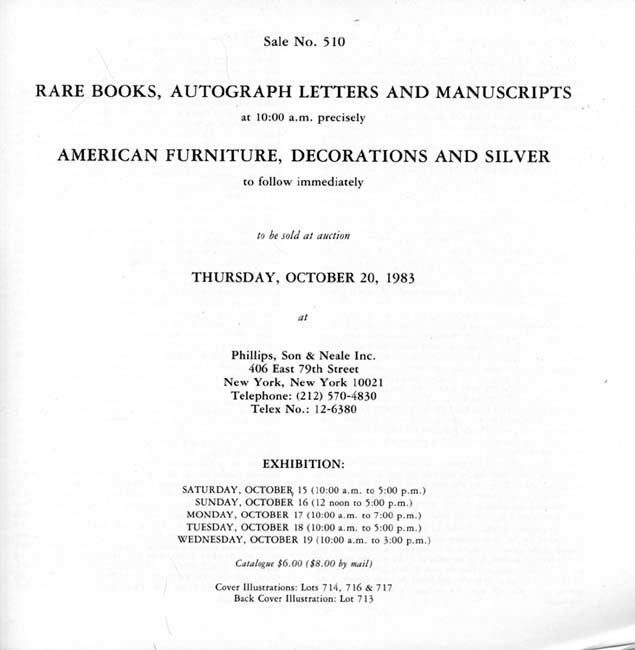
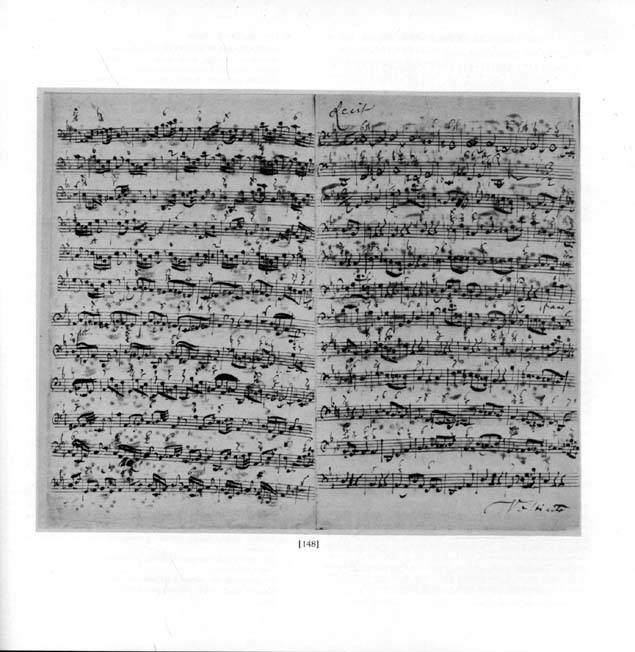
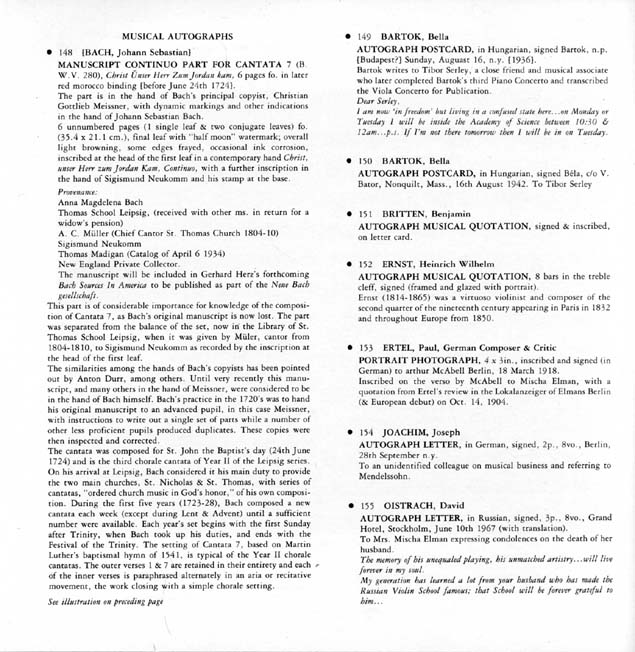
As you already know, I had the great good fortune to acquire it that morning. And, if I were Pinocchio and told you that the instant
that the hammer came down on my winning bid was not one of the happiest moments in my life, my nose would stretch from here
to Eisenach, if not all the way to Leipzig. I only hope that, by trying to do my little bit to clarify the history of this exile from the
Thomasschule, I have in some small measure proven myself worthy of the trust that has been placed in me to guard this precious
bit of Bachiana until that inevitable time when it passes from me to its next guardian.
And, maybe, just maybe, I'll be lucky enough to continue to be unable to get away from Cantata No. 7. Perhaps I will walk into an
antique store or a thrift shop one day, spot, and then be able to afford to buy, a sheet of Halfmoon watermarked paper with staff
after staff of notes in black-brown ink, framed and hanging on the wall, gathering dust, that is a handwritten figured continuo part,
transposed down from G to F, containing those rumbling eights, sixteenths, and thirty-seconds that Paul Ulanowsky realized so
beautifully when accompanying Norman Farrow in Town Hall on February 8, 1961.
Copyright, Teri Noel Towe, 1989, 1997, 2001
If you are interested in a discography of Christ unser Herr zum Jordan kam and a discussion of this wonderful cantata, please visit
the page devoted to BWV7 at Aryeh Oron's remarkable Bach Cantatas Website.
Please click on  to return to the Johann Sebastian Bach Index Page.
to return to the Johann Sebastian Bach Index Page.
Please click on the  to return to the Teri Noel Towe Welcome Page.
to return to the Teri Noel Towe Welcome Page.
teritowe@alumni.Princeton.EDU
Copyright, Teri Noel Towe, 1989, 1997, 2001
All Rights Reserved
The The Curious History of an Exile from the Thomasschule: Some Observations on the Provenance of the Original Figured
Organ Player's Part to Christ unser Herr zum Jordan kam, BWV 7 Page at the Teri Noel Towe Home Pages
is a PPP Free web page.

The The Curious History of an Exile from the Thomasschule: Some Observations on the Provenance of the Original Figured
Organ Player's Part to Christ unser Herr zum Jordan kam, BWV 7 Page at the Teri Noel Towe Home Pages has received
the HIP Woolly Mammoth Stamp of Approval from The HIP-ocrisy Home Page.